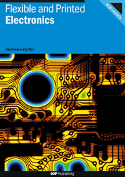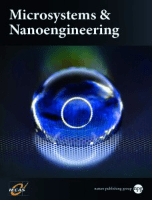
npj Flexible Electronics
Scope & Guideline
Innovating Tomorrow's Electronic Solutions
Introduction
Aims and Scopes
- Flexible and Stretchable Electronics:
Research on materials and devices that can maintain functionality while being bent, stretched, or otherwise deformed, enabling integration into non-planar surfaces. - Wearable Health Monitoring Technologies:
Development of sensors and devices that can be worn on the body to monitor physiological parameters, enhancing personal health management and medical diagnostics. - Advanced Material Science:
Innovations in materials such as hydrogels, conductive polymers, and nanomaterials that improve the performance and functionality of flexible electronic devices. - Integration of Electronics with Bioengineering:
Exploration of bio-compatible and bio-inspired electronic systems that interface seamlessly with biological tissues for medical applications. - Energy Harvesting and Management:
Techniques for capturing and utilizing ambient energy sources to power flexible devices, focusing on sustainability and self-sufficiency. - Smart Textiles and E-Textiles:
Research into textiles integrated with electronic components for applications in fashion, sports, and healthcare. - Flexible Photonics and Optoelectronics:
Study and development of devices that utilize light for various applications, including displays, sensors, and communication systems. - Artificial Intelligence and Machine Learning Integration:
Utilization of AI and machine learning techniques in the development of smart flexible electronics, enhancing their functionality and adaptability.
Trending and Emerging
- Biocompatible and Bioinspired Electronics:
Growing interest in devices that mimic biological systems or integrate with biological tissues for applications in healthcare, such as implantable sensors and biofeedback devices. - Smart Health Monitoring Systems:
Increased focus on sophisticated wearable devices that leverage flexible electronics for continuous health monitoring, including stress detection and biometric measurements. - Energy-Efficient and Sustainable Technologies:
Emerging research on energy harvesting methods and sustainable materials for flexible electronics, reflecting a global trend towards environmentally friendly technologies. - Multi-Modal and Multifunctional Sensors:
Development of sensors capable of measuring multiple physical parameters, driven by the demand for more comprehensive health and environmental monitoring solutions. - Artificial Intelligence in Flexible Electronics:
Integration of AI and machine learning into flexible electronics for enhanced data processing, predictive analytics, and smart functionalities. - Flexible Photonic Devices:
A trend towards the development of flexible photonic devices, including displays and sensors that utilize light for enhanced performance and new functionalities. - Telemedicine and Remote Health Solutions:
Research focusing on remote health monitoring technologies that utilize flexible electronics to support telemedicine applications, particularly in the wake of the COVID-19 pandemic.
Declining or Waning
- Traditional Rigid Electronics:
As flexible and stretchable technologies gain prominence, traditional rigid electronic systems are being overshadowed, with fewer publications focusing on non-flexible designs. - Basic Materials Research Without Application Focus:
There appears to be a decline in purely theoretical studies that do not emphasize practical applications or integration into devices, as researchers increasingly seek real-world applications. - Single-Function Sensors:
The focus has shifted away from simple sensors to multifunctional devices that can monitor multiple parameters simultaneously, leading to a decrease in publications on single-function sensors. - Non-Wearable Electronics:
With the rise in demand for wearable technologies, research on non-wearable electronic devices has seen a reduction in emphasis, reflecting changing market and research priorities.
Similar Journals

Flexible and Printed Electronics
Connecting Materials Science with Engineering ExcellenceFlexible and Printed Electronics, published by IOP Publishing Ltd, is a leading journal dedicated to advancing the field of flexible and printed materials within the realm of electrical and electronic engineering. With an impressive Q2 ranking in both Electrical and Electronic Engineering and Electronic, Optical, and Magnetic Materials, this journal is recognized for its significant contributions to the understanding and application of innovative electronic devices and systems. Covering a wide array of topics from materials science to engineering applications, it serves as a vital resource for researchers, professionals, and students alike. The journal's rigorous peer-review process and commitment to high-quality publications ensure that readers are exposed to cutting-edge research and developments. Submissions are welcomed from global contributors, providing a platform for the dissemination of groundbreaking ideas and technologies. With its impressive impact in the academic community, Flexible and Printed Electronics is poised to influence the future of electronics and materials technology.

OPTICAL AND QUANTUM ELECTRONICS
Connecting Theory and Application in Quantum ElectronicsOPTICAL AND QUANTUM ELECTRONICS, published by SPRINGER, is a premier journal dedicated to advancing the fields of atomic and molecular physics, optics, and electronic engineering. With an ISSN of 0306-8919 and an E-ISSN of 1572-817X, this journal has established itself as a vital resource for researchers, professionals, and students alike, contributing to the discourse from its inception in 1969 to its continued publications through 2024. It holds impressive rankings in Scopus, placing within the top percentiles for its categories, specifically in the 64th for Electrical and Electronic Engineering and 63rd for Atomic and Molecular Physics. Though it does not currently offer open access options, the journal's robust impact factor reflects its importance within its field, making it an essential reference point for cutting-edge research and developments in materials science and optics. Through its rigorous peer-review process, OPTICAL AND QUANTUM ELECTRONICS remains committed to publishing high-quality, influential studies that push the boundaries of innovation and understanding in these dynamic areas of science.

Frontiers of Optoelectronics
Shaping Tomorrow’s Technologies Through OptoelectronicsFrontiers of Optoelectronics is a prestigious peer-reviewed journal published by HIGHER EDUCATION PRESS, focusing on the rapidly evolving fields of electrical engineering, optical science, and material science. With its inception in 2012 and an impressive impact factor achieved by being ranked Q1 in both Electrical and Electronic Engineering and Electronic, Optical and Magnetic Materials as of 2023, this journal exemplifies excellence in research dissemination. Operating under an Open Access model since 2022, it ensures timely and widespread accessibility to cutting-edge advancements and innovative applications in optoelectronics, making it an essential resource for researchers, professionals, and students alike. The journal is indexed in Scopus, with notable ranking positions—Rank #143/797 in Electrical and Electronic Engineering and Rank #55/284 in Electronic, Optical and Magnetic Materials—highlighting its significant contribution to the academic community. Based in Beijing, China, the journal fosters a global dialogue around key technological trends, ultimately driving further development in the field.

Electronic Materials Letters
Unveiling the Potential of Advanced MaterialsElectronic Materials Letters is a distinguished journal dedicated to the dissemination of research in the field of electronic, optical, and magnetic materials. Published by the Korean Institute of Metals and Materials, this journal has established itself as a critical platform for scholars and practitioners since its inception in 2008, with coverage extending through 2024. With an ISSN of 1738-8090 and an E-ISSN of 2093-6788, it has achieved a commendable Q3 categorization for 2023, ranking 107 out of 284 in the Scopus database's specialized field, reflecting its relevance with a 62nd percentile position among its peers. Although this journal operates under a traditional access model, its rigorous peer-review process ensures that only the most impactful research reaches its audience, thereby maintaining high scholarly standards. Positioned in South Korea at the heart of technological innovation, Electronic Materials Letters plays a vital role in bridging the gap between theoretical investigations and practical applications, making it an essential resource for researchers, industry professionals, and students aiming to thrive in the rapidly evolving materials science landscape.

Frontiers in Materials
Driving Progress with Open Access Research.Frontiers in Materials, an esteemed journal published by FRONTIERS MEDIA SA, is a leading platform in the field of Materials Science, with a notable impact factor placing it in the Q2 category of its discipline as of 2023. Since its establishment as an Open Access journal in 2014, it has fostered considerable academic exchange, allowing researchers from around the globe to share their innovative findings and insights. Based in Lausanne, Switzerland, this journal not only emphasizes high-quality peer-reviewed articles but also prioritizes rapid dissemination of research, as evidenced by its commendable Scopus ranking of #62 out of 196 in Materials Science (miscellaneous). By consistently striving to bridge the gap between academia and practical applications, Frontiers in Materials serves as an invaluable resource for researchers, professionals, and students seeking to delve into cutting-edge advancements and transformative applications in materials science.

APL Materials
Exploring breakthroughs in materials research.APL Materials is a prestigious open access journal published by AIP Publishing that has been at the forefront of disseminating cutting-edge research in the fields of materials science and engineering since its inception in 2013. With an impressive impact factor reflecting its significance, APL Materials ranks securely in the Q1 quartile in both Engineering (miscellaneous) and Materials Science (miscellaneous) categories, underscoring its role as a vital resource for innovative scientific inquiry. Ranked highly in Scopus, particularly in General Engineering (24/307) and General Materials Science (78/463), the journal provides a platform for researchers, professionals, and students to share their findings and advancements that push the boundaries of material applications. Furthermore, its open access policy ensures that high-quality research is freely available to a global audience, fostering collaborative advancements in the scientific community. As the journal continues to evolve through to 2024, it remains committed to presenting groundbreaking studies that contribute to the advancement of materials science and engineering disciplines.Explore APL Materials to stay at the cutting edge of research and innovation.

Advances in Electrical and Electronic Engineering
Connecting Research with Real-World Engineering SolutionsAdvances in Electrical and Electronic Engineering is a distinguished peer-reviewed journal published by VSB-TECHNICAL UNIVERSITY OSTRAVA, fostering an open-access platform since 2002 that is instrumental in disseminating innovative research and developments in the field of electrical and electronic engineering. With an ISSN of 1336-1376 and an E-ISSN of 1804-3119, this journal provides a vital resource for researchers, professionals, and students striving to stay at the forefront of this dynamic sector. Despite its present Q4 ranking in the Electrical and Electronic Engineering category and a Scopus rank of 598 out of 797, the journal aims to elevate its impact and reach through dedicated contributions that explore emerging technologies, theoretical advancements, and practical implementations. With its commitment to accessibility, authors are encouraged to publish work that can significantly advance our understanding of electrical systems and contribute to the global engineering community from its base in Czech Republic.

Microsystems & Nanoengineering
Transforming Ideas into Nanoscale RealitiesMicrosystems & Nanoengineering, published by SpringerNature, stands at the forefront of advancing knowledge in the fields of atomic and molecular physics, condensed matter physics, electrical and electronic engineering, and materials science. With an impressive impact factor and categorized in Q1 across multiple prestigious fields in 2023, this journal not only provides a platform for high-quality research but also reflects the vitality of innovations within these disciplines. Since its transition to Open Access in 2015, it has significantly broadened accessibility for researchers, professionals, and students globally, facilitating the dissemination of groundbreaking findings. Addressed in the United Kingdom, with a focus on interdisciplinary collaboration, Microsystems & Nanoengineering aims to foster connections between theoretical advancements and practical applications, serving as a crucial resource for those engaged in cutting-edge nanoscale technologies and microsystems development. Immerse yourself in the latest studies and engage with the vibrant community that shapes the future of science and engineering.

Journal of Electronics & Information Technology
Transforming Ideas into Innovations in ElectronicsJournal of Electronics & Information Technology, published by the prestigious Chinese Academy of Sciences, Institute of Electronics, stands as a vital resource in the field of Electrical and Electronic Engineering. With an ISSN of 1009-5896, this journal has been dedicated to the dissemination of advanced research and innovative applications since its inception in 2001. It holds a competitive position within its category, ranked Q3 in the 2023 Scopus database, reflecting its contribution to the scientific community. The journal addresses a wide array of topics related to electronics and information technology, making it indispensable for researchers, professionals, and students aiming to stay at the forefront of technological advancements. Although it operates under a traditional model of access, its cumulative output remains pivotal for knowledge sharing and innovation in the rapidly evolving landscape of electronic engineering. With its commitment to excellence, the Journal of Electronics & Information Technology aims to foster a thriving academic environment and promote impactful research within the discipline.

ELECTRONICS LETTERS
Pioneering Open Access for Global Impact.ELECTRONICS LETTERS, published by WILEY, is a leading peer-reviewed journal dedicated to the field of Electrical and Electronic Engineering. With a rich history dating back to 1965, this journal serves as a prominent platform for disseminating novel research and innovations in electronics, covering topics such as circuit design, telecommunications, and signal processing. In 2021, the journal transitioned to an Open Access format, ensuring that cutting-edge research is freely accessible to a global audience, thereby enhancing its impact and outreach. The journal currently holds a Q3 quartile ranking in its category, reflecting its solid position among its peers, and ranks #451 out of 797 in Scopus for Electrical and Electronic Engineering, placing it within the 43rd percentile. ELECTRONICS LETTERS is essential for researchers, professionals, and students looking to stay abreast of the latest developments and contribute to advancements in the field, fostering collaboration and knowledge sharing in a rapidly evolving landscape.